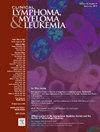SOHO State of the Art Updates and Next Questions | Atypical Chronic Myeloid Leukemia: Pathogenesis, Diagnostic Challenges and Therapeutic Strategies
IF 2.7
4区 医学
Q2 HEMATOLOGY
引用次数: 0
Abstract
Atypical chronic myeloid leukemia (aCML) is a rare and challenging clonal hematopoietic disorder within the myelodysplastic/myeloproliferative neoplasm (MDS/MPN) spectrum. Over the past two decades, substantial progress has been made in understanding the genetic mechanisms driving aCML, revealing a complex and heterogeneous mutational landscape. Key ancestral mutations, such as ASXL1 and ETNK1, have been identified, providing a foundation for the pathogenesis and for the possible emergence of secondary abnormalities, particularly in epigenetic regulation (eg, SETBP1), and in splicing process (eg, SRSF2). These molecular insights have been integrated into current diagnostic classifications, refining disease characterization and offering potential targets for precision therapies. Despite these advances, significant clinical challenges persist due to the disease's rarity and the lack of randomized clinical trials. Therapeutic strategies remain inadequately defined, with allogeneic stem cell transplantation being the only curative option. This review provides an overview of the molecular, clinical, and therapeutic information that may pave the way for essential advancements in the proper management of this disease.
非典型慢性髓性白血病:发病机制、诊断挑战和治疗策略。
非典型慢性髓系白血病(aCML)是一种罕见且具有挑战性的克隆性造血疾病,属于骨髓增生异常/骨髓增生性肿瘤(MDS/MPN)谱系。在过去的二十年中,在了解aCML的遗传机制方面取得了实质性进展,揭示了一个复杂和异质的突变景观。关键的祖先突变,如ASXL1和ETNK1,已经被发现,为发病机制和继发性异常的可能出现提供了基础,特别是在表观遗传调控(如SETBP1)和剪接过程(如SRSF2)中。这些分子的见解已经被整合到当前的诊断分类中,改进了疾病特征,并为精确治疗提供了潜在的靶点。尽管取得了这些进展,但由于该病的罕见性和缺乏随机临床试验,重大的临床挑战仍然存在。治疗策略仍然不明确,同种异体干细胞移植是唯一的治疗选择。这篇综述提供了分子、临床和治疗信息的概述,这些信息可能为正确治疗这种疾病铺平道路。
本文章由计算机程序翻译,如有差异,请以英文原文为准。
求助全文
约1分钟内获得全文
求助全文
来源期刊

Clinical Lymphoma, Myeloma & Leukemia
ONCOLOGY-HEMATOLOGY
CiteScore
2.70
自引率
3.70%
发文量
1606
审稿时长
26 days
期刊介绍:
Clinical Lymphoma, Myeloma & Leukemia is a peer-reviewed monthly journal that publishes original articles describing various aspects of clinical and translational research of lymphoma, myeloma and leukemia. Clinical Lymphoma, Myeloma & Leukemia is devoted to articles on detection, diagnosis, prevention, and treatment of lymphoma, myeloma, leukemia and related disorders including macroglobulinemia, amyloidosis, and plasma-cell dyscrasias. The main emphasis is on recent scientific developments in all areas related to lymphoma, myeloma and leukemia. Specific areas of interest include clinical research and mechanistic approaches; drug sensitivity and resistance; gene and antisense therapy; pathology, markers, and prognostic indicators; chemoprevention strategies; multimodality therapy; and integration of various approaches.
 求助内容:
求助内容: 应助结果提醒方式:
应助结果提醒方式:


